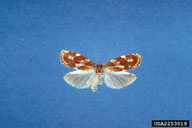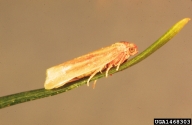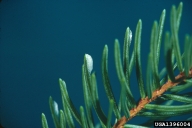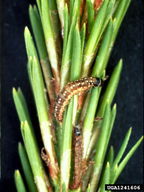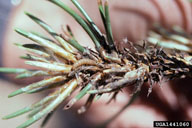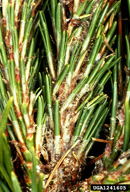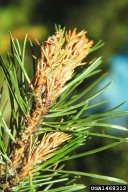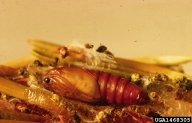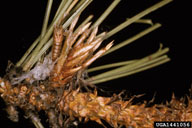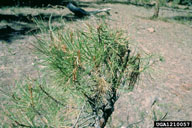Sugar pine tortrix
Choristoneura lambertiana Busck (Lepidoptera: Tortricidae)
Orientation to pest
Sugar pine tortrix, Choristoneura lambertiana Busck, is a tortricid moth native to western North American that feeds on various conifers, especially pines. This species includes many different races that vary in appearance or aspects of biology, some of which have been given subspecies names. This moth's life history is similar to that of other better known members of the genus. Adults fly in summer (July and August) and lay eggs on the foliage of the host plant. Young larvae overwinter in hibernaculae on the tree trunk and reemerge the following spring when they feed by mining needle sheaths and staminate cones. New foliage buds are also consumed. Several larvae (1-5) may feed together on the same shoot. Larvae web the needles into feeding shelters and pupae are formed among the webbed needles. Damaged trees are not likely to die, but tops may be killed.
Hosts commonly attacked
The sugar pine tortrix feeds on various pines, including sugar (Pinus lambertiana Douglas), lodgepole (Pinus contorta Douglas), limber (Pinus flexilis E. James), and ponderosa (Pinus ponderosa Douglas ex. C. Lawson) pines, as well as some other conifers, including Douglas-fir (Pseudotsuga menziesii [Mirb.] Franco) and juniper (Juniperus).
Distribution
This moth is found in several western U.S. states (including California, Colorado, Idaho, Montana, Oregon, and Montana). Ranges by subspecies have been recorded as follows: Choristoneura lambertiana lambertiana (confirmed: Siskiyou County and Ashland, Oregon. Uncertain: Alberta and British Columbia in Canada and Idaho, Montana, eastern Oregon and Wyoming in the United States); Choristoneura lambertiana ponderosana (Arizona, Colorado, Nevada, New Mexico, western New England, South Dakota); Choristoneura lambertiana subretiniana (California and Oregon).
Images of sugar pine tortrix
| Figure 1. Adults (two forms with different color patterns) of the sugar pine tortrix, Choristoneura lambertiana | Figure 2. Egg mass of the sugar pine tortrix |
| Figure 3. Larvae of the sugar pine tortrix | Figure 4. Needles that have been clipped and webbed together by sugar pine tortrix larvae |
| Figure 5. Pupa of the sugar pine tortrix (left) and skin of emerged pupa (right) | Figure 6. Damage to tips of small pine from larvae of the sugar pine tortrix |
Important biological control agents related to this pest species
As with other Chorisoneura species, the sugar pine tortrix is affected by a large complex of natural enemies, especially parasitoids, of which some 22 species are known from rearing. However, the effect, if any, of these species on fluctuations in density of this pest is unknown.
Web links for information on sugar pine tortrix
- Wikipedia Article | Wikipedia, the free encyclopedia
Includes information on ranges of subspecies - Fact Sheet | Colorado State University Extension
Provides general information on subspecies associated with ponderosa pine
Articles
- Stevens, R. E., T. K. Borg,and T. O. Thatcher. 1977. Notes on a pine-feeding budworm, Choristoneura lambertiana ponderosana (Lepidoptera: Tortricidae), in the Colorado Rockies. The Canadian Entomologist 109: 1269-1274.
- Powell, J. A. 1995. Biosystematic Studies of Conifer-feeding Choristoneura (Lepidoptera: Tortricidae) in the Western United States. University of California Publications, Entomology, Berkeley, California. (contains range information)
